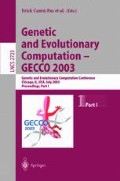Abstract
We study the effect of natural selection on the performance of phylogeny reconstruction algorithms using Avida, a software platform that maintains a population of digital organisms (self-replicating computer programs) that evolve subject to natural selection, mutation, and drift. We compare the performance of neighbor-joining and maximum parsimony algorithms on these Avida populations to the performance of the same algorithms on randomly generated data that evolve subject only to mutation and drift. Our results show that natural selection has several specific effects on the sequences of the resulting populations, and that these effects lead to improved performance for neighbor-joining and maximum parsimony in some settings. We then show that the effects of natural selection can be partially achieved by using a non-uniform probability distribution for the location of mutations in randomly generated genomes.
Access this chapter
Tax calculation will be finalised at checkout
Purchases are for personal use only
Preview
Unable to display preview. Download preview PDF.
References
Hillis D.M.: Approaches for Assessing Phylogenetic Accuracy, Syst. Biol. 44(1) (1995) 3–16
Huelsenbeck J.P.: Performance of Phylogenetic Methods in Simulation, Syst. Biol. 44(1) (1995) 17–48
Hillis D., Bull J.J., White M.E., Badgett M.R., Molineux L.J.: Experimental Phylogenetics: Generation of a Known Phylogeny. Science 255 (1992) 589–592
Ramnaut A. and Grassly N. C.: Seq-Gen: An application for the Monte Carlo simulation of DNA sequence evolution along phylogenetic trees. Comput. Appl. Biosci. 13 (1997) 235–238
Ofria C., Brown C.T., and Adami C.: The Avida User’s Manual, 297—350 (1998)
Wilke C.O., Adami C.: The biology of digital organisms. TRENDS in Ecology and Evolution, 17:11 (2002) 528–532
Adami C., Ofria C., and Collier T.C.: Evolution of Biological Complexity. Proc. Natl. Acad. Sci. USA 97 (2000) 4463–4468
Wilke C.O., et. al.: Evolution of Digital Organisms at High Mutation Rates Leads to Survival of the Flattest. Nature, 412 (2001) 331–333
Lenski R.E., et. al.: Genome Complexity, Robustness, and Genetic Interactions in Digital Organisms. Nature 400 (1999) 661–664
Elena S.F. and Lenski, R.E.: Test of Synergistic Interactions Among Deleterious Mutations in Bacteria. Nature 390 (1997) 395–398
Gaut B.S. and Lewis P.O.: Success of Maximum Likelihood Phylogeny Inference in the Four-Taxon Case, Mol. Biol. Evol 12(1) (1995) 152–162
Tateno Y., Takezaki N., and Nei M.: Relative Efficiencies of the Maximum-Likelihood, Neighbor-joining, and Maximum Parsimony Methods When Substitution Rate Varies with Site, Mol. Biol. Evol. 11(2) (1994) 261–277
Saitou N. and Nei M.,: The Neighbor-Joining Method: A New Method for Reconstructing Phylogenetic Trees, Mol. Biol. Evol. 4 (1987) 406–425
Studier J. and Keppler K.: A Note on the Neighbor-Joining Algorithm of Saitou and Nei, Mol. Biol. Evol. 5 (1988) 729–731
Fitch W.: Toward Defining the Course of Evolution: Minimum Change for a Specified Tree Topology, Systematic Zoology, 20 (1971) 406–416
Lenski E., Ofria C., Collier C. and Adami C.: Genome Complexity, Robustness and Genetic Interactions in Digital Organisms, Nature, 400 (1999) 661–664
Author information
Authors and Affiliations
Editor information
Editors and Affiliations
Rights and permissions
Copyright information
© 2003 Springer-Verlag Berlin Heidelberg
About this paper
Cite this paper
Hang, D., Ofria, C., Schmidt, T.M., Torng, E. (2003). The Effect of Natural Selection on Phylogeny Reconstruction Algorithms. In: Cantú-Paz, E., et al. Genetic and Evolutionary Computation — GECCO 2003. GECCO 2003. Lecture Notes in Computer Science, vol 2723. Springer, Berlin, Heidelberg. https://doi.org/10.1007/3-540-45105-6_2
Download citation
DOI: https://doi.org/10.1007/3-540-45105-6_2
Published:
Publisher Name: Springer, Berlin, Heidelberg
Print ISBN: 978-3-540-40602-0
Online ISBN: 978-3-540-45105-1
eBook Packages: Springer Book Archive

